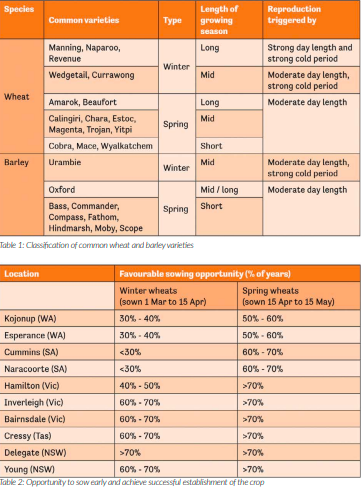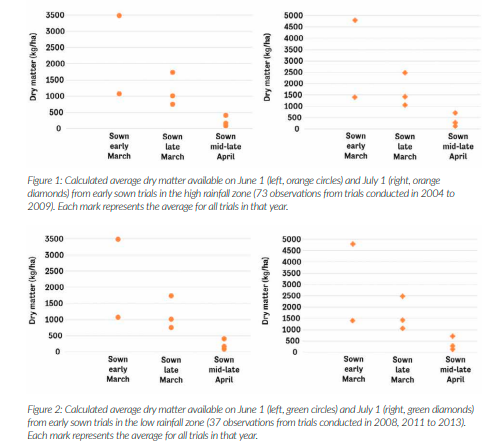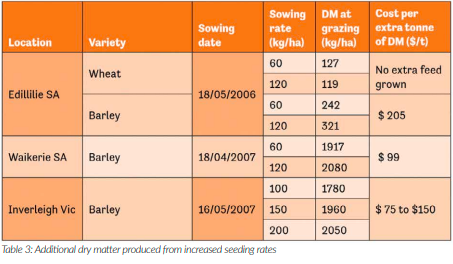Many farmers have commented that the greatest benefit from grazing their winter crops has been the additional pasture grown which can then be used by livestock at a later stage. This deferment requires the additional pasture production and better livestock condition from grazing the crop to be valued.
The GrassGro model was used to calculate the whole farm benefits from grazing crops for a prime lamb/ cropping enterprise in South West Victoria. Ewes were stocked at 9/ ha, lambed on August 1, with lambs sold on March 15. The modelling used 48 years of historic climatic data (from 1961 to 2006) and was able to capture the obvious benefits such as increased pasture production as well as the subtle benefits of increased reproductive performance and better lamb growth in spring because of the extra feed available. The grazing period was 4 weeks. All livestock were ‘grazed’ on crops while the pasture was spelled3. At the end of the crop grazing period, all animals returned to the pasture. It was assumed there was no loss in grain yield due to grazing.
The key findings were:
• Grazing for a month in June resulted in an extra 200 kg/ha of pasture by August 1 compared to no grazing
• Deferring the start of grazing until July but then grazing for a month resulted in an extra 260 kg/ha of pasture by August 1
• The probability of lambs reaching the target weight of 45 kg liveweight by March 15 increased by 11%
• The economic benefit was $16/ ha for the June deferment and $53/ha for the July deferment.
To enable full deferment for a month in July, it is estimated that half the farm would need to be in crop and be used for grazing. More crop would be required with a June grazing.
Further MIDAS computer modelling the Central Wheatbelt and South Coast of Western Australia showed that grazing crops also has the potential to improve farm profit by providing additional feed in midwinter, but achieving the potential benefits relied on increasing stocking rates and supplementary feeding at times to levels that might be considered extreme by some farmers. The analysis also showed higher levels of crop dry matter substantially increases the profitability of grazing crops, whilst small yield penalties of around 10% as a result of grazing rapidly eroded most of the benefits.
What and how to do it (agronomy at the paddock scale)
Successful grazing of crops requires the production of useful amounts of dry matter soon after sowing, with the ability for the plants to recover dry matter quickly after grazing. To maximise the chances of realising this, the following needs to be considered.
Paddock selection
Choose paddocks that provide early sowing opportunities. These are likely to be paddocks that:
• Are low in weeds. Paddocks with low weed densities can be sown earlier because there is no need to wait for a germination and kill before sowing. Heavy weed burdens compete with the crop for moisture, reducing early dry matter production and compete against the crops as it recovers from grazing. Furthermore, grazing will open up the crop canopy letting light between rows and favouring weed growth after grazing.
• Wet up sufficiently after early rain to allow for an even germination of the crop and for subsoil moisture to be retained. Stored soil moisture is often vital to maintain crop survival if adequate follow up rains fail to occur.
• Have good soil fertility. Adequate phosphorus and nitrogen will provide opportunity for rapid leaf growth. Paddocks that are likely to have favourable mineralised nitrogen from a previous season are desirable. A crop with adequate nutrition will also recover faster after grazing.
• Low disease status. Early sowing in warmer conditions can often exacerbate underlying disease problems.
What to sow
Dual purpose or winter wheats immediately come to mind when thinking about crops suitable for grazing. Yet both spring and winter type crops can be grazed, it is just their development and therefore management decisions such as when they are sown and grazed need to be slightly different (see side story ). There is a lot of information available about crop varieties. They are commonly grouped into winter or spring types, by the length of growing season and by their maturity pattern (early, mid, late etc). Behind these grouping is the cold period (vernalisation) and day length (photoperiod) requirements of each variety.
Varieties are constantly entering the market and it is recommended you consult with your local agronomist to ensure the variety chosen suits the time of sowing and optimum flowering time. However to help gain a broad understanding of the different classifications, some common wheat and barley varieties have been listed (table 1). While seasonal conditions have a strong influence on the amount of dry matter grown, in general barley will produce feed earlier than winter or spring wheats when sown at the same time. Spring wheats are generally faster growing than winter wheats. The amount of dry matter that triticale crops produce falls between barley and wheat.

Because all crops can be grazed, the choice variety within the broad classification becomes less important. Deciding what to sow should be primarily determined by the existing crop rotation, feed requirements and other paddock considerations rather than the variety.
When to sow (time of sowing)
Cereals crops and canola with strong winter habit can be sown early in the year (March to mid-April) because they need a period of cold and short days before they will run to head. Earlier sowing combined with favourable weather conditions can result in large amounts of dry matter for grazing. Spring varieties sown early, even including long season types, will flower too early leaving the crop vulnerable to frost damage. For these varieties a mid to late April sowing is recommended. Short season spring varieties need to be sown even later, at the more conventional May sowing time.

Moisture for successful establishment Successful early sowing obviously requires good establishment and subsequent growth. A recent study by the CSIRO5 examined the probability of successfully establishing winter habit crops early in the season (1 March to 15 April) and earlier sown spring habit crops (15 April to 15 May) in the higher rainfall zones across Southern and Western Australia. As expected the chances of successful establishment varied considerably across the country and improved with later sowing (table 2).

Growth after establishment
The amount of dry matter produced from early sowing, even with successful establishment, is dependent on adequate stored soil moisture or follow up rain. Figures 1 and 2 present dry matter production from early sown trials over a range of years. Results have been adjusted to indicate the average dry matter produced at the start of June and the start of July. Additional factors beyond time of sowing and variety selection also need to be considered when deciding on when to sow. These include issues around weed control and potential for increased crop disease.

Options for increasing dry matter production up to growth stage 30
Apart from early sowing, the most common approach to increase dry matter production for grazing is by increasing sowing rate (see side story). Trials from both high and low rainfall zones illustrates the potential benefit from higher sowing rates if seasonal conditions are favourable (table 3). If conditions are unfavourable, higher seeding rates have limited value.

